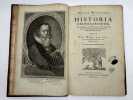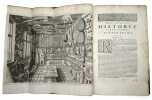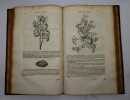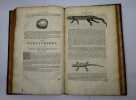CUVIER | WORM, Ole
Museum Wormianum. Seu Historia Rerum rariorum, Tam Naturalium, quam Artificialium, tam Domesticarum, quam Exoticarum
, 1655, in-folio, Amstelodami, Apud ludovicum et Danielem Elsevirios, Veau granité, dos à 6 nerfs orné de caissons à grotesques aux petits fers, tranches jaspées de rouges. Reliure de l'époque, ... quæ Hafniæ Danorum in ædibus Authoris servantur. Adornata ab...Variis & accuratis Iconibus illustrata. Édition originale rare de cette somme magnifique, l'une des premières consacrées à la description d'un cabinet de curiosités. Elle dépeint le musée d'histoire naturelle du médecin et savant danois Ole Worm (1588- 1654) en quatre parties : minéraux, plantes, animaux et "artificialia" manufacturés par l'homme. L'ouvrage a paru après la mort de son auteur, son fils Willum Worm se chargeant de l'édition, qu'il dédie au roi de Danemark Frédéric III. L'ouvrage est célèbre pour l'illustration figurant l'intérieur du cabinet, gravure devenue emblématique des cabinets de curiosités, avec la belle planche gravée par Wingendorp. Le titre du catalogue et l'adresse "Ex officina Elzeviriorum" sont inscrits, sur la table au premier plan, reposant sur un dallage en damier. Tout autour, sur des étagères, au mur et entre les solives du plafond, sont exposés les objets de la collection : carapaces de tortues, poissons, crustacés et mammifères naturalisés, roste et défense de narval, caissettes de coquillages et de minéraux, vêtements du Nouveau monde et autres lances ou pagaies, statuettes de facture occidentale, etc. Le reste du volume est illustré d'un portrait d'Ole Worm d'après Carl van Mander et outre de nombreux bois dans le texte , de 11 gravures en taille- douce, dont 2 à pleine page. Précieux exemplaire de Cuvier, avec son timbre humide, le cachet "Legs de G. Cuvier à M. Valenciennes" recouvert à l'encre noire, et le timbre du Muséum d'histoire naturelle. Il provient de la collection de Melvin Edward Jahn (avec son étiquette ex-libris, acquis par ce dernier chez Quaritch en 1961.) Reliure restaurée. Rousseurs éparses en début et fin de volumes, 1 cahier un peu bruni. Références : Willems 772. Nissen ZBI, 4473 (à l'adresse de Daniel et Louis Elzevier). Couverture rigide
Reference : 92655
Bon Amstelodami, Apud ludovicum
Bookseller's contact details
Librairie Alain Brieux
Jean Bernard Gillot
48, rue Jacob
75006 Paris
France
331 42 60 21 98
Payment mode



Sale conditions
Vente aux conditions habituelles de la Librairie
1 book(s) with the same title
Museum Wormianum. Seu Historia Rerum rariorum, Tam Naturalium, quam Artificialium, tam Domesticarum, quam Exoticarum, quæ Hafniæ Danorum in ædibus Authoris servantur. Adornata ab...Variis & accuratis Iconibus illustrata. - [MUSEUM WORMIANUM]
Lugduni Batavorum (Leiden), Ex Officina Elzeviriorum, 1655. Folio. 18th century full calf with gilt spine. Gilding worn and some overall wear to boards, but fine and tight. Capitals restored. Internally very nice and clean, with just a bit of light brownspotting to the first and last leaves (dedication and index). Generally unusally nice, clean, and crisp. A small discreet stamp (Doublette der L.U. Bibl. Erl.) to title-page and a neat contemporary owner's inscription. Good margins. Bound without the portrait, which is often the case. Otherwise complete, with the magnificent double-page engaved plate showing the interior of the museum by Wingendorp, 11 beautiful engraved illustrations (one of which consisting in two illustrations), two of which are full-page (one being the famous one of the horn), and numerous lovely, and elaborate woodcut illustrations in the text. Woodcut title-vignette, woodcut vignettes and initials. Title-page, (4) pp. of dedication, (6) pp. of preface and index, double-page plate, 389, 3 (index) pp. A lovely copy, rarely seen in such nice condition.
The scarce first edition of this monumental work in early modern museum literature, constituting the catalogue of the first Danish museum and one of the most important cabinets of curiosities in Europe. The magnificent double-page engraved plate depicting the interior and outlay of the museum is one of the most well known and famous illustrations from any ""Wunderkammer""-book, iconographically summizing what we understand by the genre.The Museum Wormianum was filled with preserved animals, horns, tusks, skeletons, minerals, as well as various man-made objects that Worm found equally fascinating and interesting, either due to their age, their beauty, the wonder of their execution, their being exotic, etc., many of them depicted here in the finest manner. The text of the ""Museum Wormianum"" is divided into four books, the first three dealing with minerals, plants, and animals respectively. The fourth comprises man-made objects, e.g. archeological and ethnographical items, coins and some original works of art. This, Worm's magnum opus, is not merely a catalogue of the numerous wondrous items in the collection, however, it is a scientifically based scholarly work that also contains references to, and quotations from, other writers. The famous Danish doctor, Ole Worm (1588-1654), who was professor of medicine throughout the last thirty years of his life, had become professor of physics in 1621. Already the year before, in 1620, had he begun the famous collection that would become one of the greatest cabinets of curiosites in Europe (and one of the first museums) and which would earn him the position as the first great systematic collector (within natural history) in Scandinavia. It was his then newly begun collection that enabled him, as professor of physics, to introduce demonstrative subject teaching at the university, as something completely new. He continued building and adding to his magnificent collection, now known as ""Museum Wormianum"", throughout the rest of his life. Worm used his collection, not only in his teaching (for which he was famous), but also as a starting point for his speculations on philosophy, science, natural history, etc. He is responsible for many great discoveries, e.g. for identifying the narwhal's tusk as coming from a whale rather than a unicorn, as was generally believed at the time. As was also the case with other great cabinets of curiosities, the ""Museum Wormianum"" greatly served scientific advancement, not least when the images of its content were printed, as they were here, in 1655.As Worm visited other famous cabinets of curiosities, so many foreign visitors came to see his, which was famous throughout Europe. After his death, the collection was bought by the Danish King, Frederik III, and was thus included in Det Kongelige Kunstkammer (The Royal Art Chamber). The collection is now in Statens Naturhistoriske Museum (Natural History Museum), which in November 2011 famously reprodced the ""Museum Wormianum"", from what they could see it looked like on the great double-page plate in the fabulous catalogue, as a permanent exhibition. The magnificent folio catalogue of the collection was edited and seen through press by Worm's son Willum and was published by the Elzeviers. Willems 772" Paul Grinke: From Wunderkammer to Museum: no. 75.
 Write to the booksellers
Write to the booksellers







